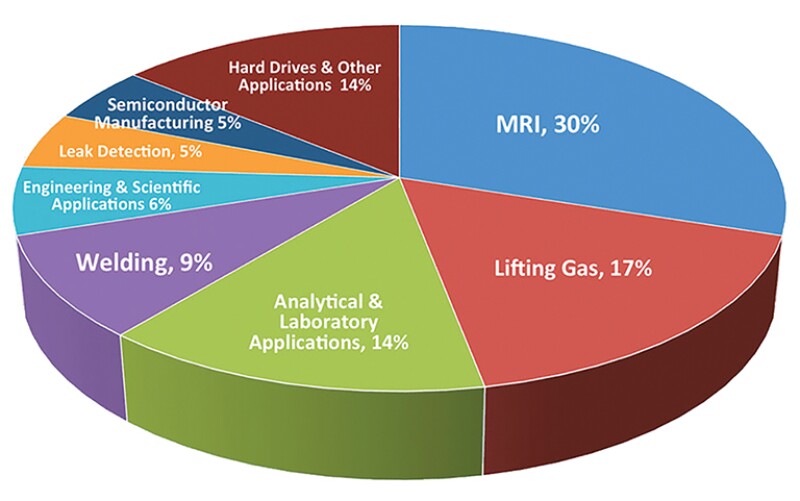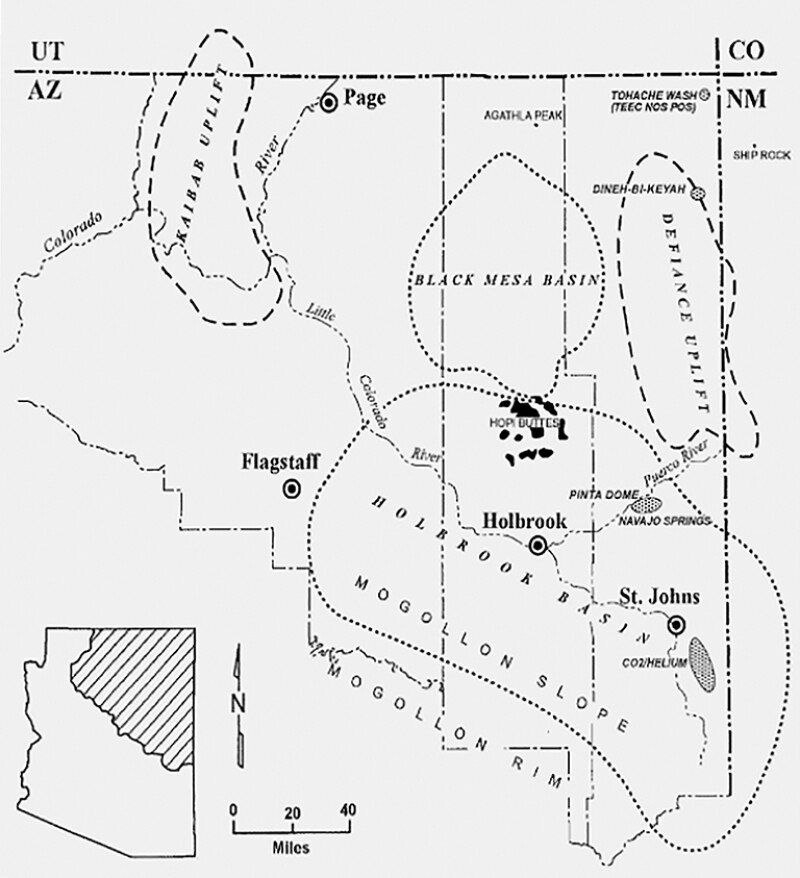Helium is one of the most abundant gases in the universe. It is used in advanced medical technologies such as MRIs and in cryogenics, aerospace applications, and microchip manufacturing. It is also used to fill party balloons. It is essential and expensive, and supplies are running low.
Helium is about 100 million times more abundant in one place—but that place is on the moon.
While trace amounts can even be found in the very air we breathe, the gas is difficult to find in commercial quantities, and those quantities are usually found as a byproduct of natural gas discoveries.
Historically, about 40% of the US supply of helium came from the Federal Helium Reserve, a US Bureau of Land Management (BLM) -operated storage reservoir, enrichment plant, and pipeline system near Amarillo, Texas. The reserve was set up in 1960 as a strategic repository so that BLM could supply crude helium to private helium-refining companies, which, in turn, refined it and marketed it to consumers.
In the mid-1990s, Congress passed a bill to sell off a large part of the reserve’s supply to help pay off the facility’s debt and effectively set in motion the federal government’s exit from the helium business. In 2013, BLM said it would begin auctioning off an increased percentage of the reserve annually as part of the bill. Last year, BLM announced the closure of the reserve.
At the time of the announcement, BLM Deputy Director for Policy and Programs William Perry Pendley said, “now it is time for the US government to remove itself from the helium business and allow the private sector to further develop this industry to meet the supply needs of the United States, creating a sustainable economic model and jobs for Americans.”
BLM held its final crude helium auction in 2019, with the price rising 135%, from $119/Mcf a year earlier to $280/Mcf. Market pricing for helium is difficult to know. It is not a traded commodity, and pricing is normally based on long-term, confidential contracts. It’s a niche market that suffers from a lack of detailed analysis due in large part to the availability of its closely held data.
The helium industry shares many aspects of the oil and gas business. Commercial deposits are found via geological survey; then, once identified, drilling begins. Outside of the search and discovery, helium can also be a useful tool for those in the oil business. It can be used for leak detection and in specialized welding because of its inert properties and high heat transfer. Additionally, as the oil field moves more toward digitalization, storage of big data will need helium for the construction of storage drives and to keep server farms cool.

Swapping Hydrocarbons for Helium
As scientific developments advance, the need for helium increases—a notion not lost on Canada-based Avanti Energy. The company’s chief executive officer (CEO), Chris Bakker, has more than 2 decades of experience in oil and gas, most recently working as a commercial negotiator with Encana/Ovintiv for major facilities and pipelines in the Montney gas play. Today, he and his team are looking for commercial helium deposits in southern Alberta and northern Montana.
“We just like to say that it’s the exact same skill set, just a pivot into a different industry,” said Bakker. “So, into different exploration areas, but the geology, the geophysics, the drilling, all of that is the same. Historically, helium is commonly a byproduct of natural gas reservoirs, but, with the price we saw back in 2018, it has encouraged companies like ours to go for helium as a primary target rather than as a byproduct.”
While some producers work to harness both natural gas and helium, Avanti is a pure-play helium explorer.
The second-lightest gas (only hydrogen is lighter), helium has a lower density than normal atmospheric gases and cannot be trapped by gravity. This is because gravity pulls more on heavier/denser matter, pushing away the lighter gas. The only place helium can go is up.
Therefore, ideal helium traps are fully sealed, structural closures in nonporous rock, allowing the gas to accumulate without escaping.
“We’ve got a number of analog wells on the Canadian side of the border that were originally targeted as natural gas wells several decades back,” Bakker explained. “They were misses for natural gas, but they had helium shows. We’ve used that data to build our geologic models as to where we should be looking. We also use trade seismic data, and we may do some proprietary seismic and build on that. There have not been a ton of wells that have been drilled to the depth that we’re looking at. Our primary targets are Cambrian, and we also see Devonian secondary targets in some areas.”
Avanti recently wrapped up a geological survey of its Aden property in southern Alberta, which has identified three potential drilling targets and confirmed a large four-way closed structure with more than 75 m of relief. Geological evaluations of nearby wells indicate nitrogen concentrations between approximately 86 and 98% and helium concentrations from about 0.60 to 2.17% in the Cambrian Sandstone, Lower Beaverhill Lake, and Upper Beaverhill Lake, providing three target pay zones for potential helium discovery. Bakker said that his company could drill at Aden before the end of the year.
“We’re lining up rig inspections now, and our intention is to drill three wells this fall,” he said. “I’m not sure what combination yet—if there are going to be three in Montana or two there and one in Alberta. We’re still working on it. Our budget is for three wells this year, and then we’ll carry on drilling in the new year with some success this year.”
As the company ramps up to drill, it recently added another oilfield veteran to its ranks. Jody Denis, formerly of Seven Generations, ARC Resources, and Birchcliff Energy, will oversee the company’s drilling programs in both Alberta and Montana as senior drilling and completions manager.

Looking for Helium in the Copper State
Farther south, Desert Mountain Energy is another pure helium player with holdings in northeastern Arizona. Its CEO and executive chairman, Robert Rohlfing, brings experience in oil and gas industry operations, including a strong geological background and more than 26 years of experience in formulating, conducting, and managing exploration, drilling, development, and production programs for oil and gas and minerals worldwide.
The company recently completed drilling its fourth well in the Holbrook basin and encountered significant shows of helium across four formations. All three previous wells in the area encountered helium. The first well in the area, Arizona 10-1, showed just over 7% helium during a limited flow test. The second well, 16-1, showed 4% helium during its flow test. Historically, the Holbrook basin has been a prolific helium producer with more than 9.2 Bcf of helium produced from 22 wells in three fields—Pinta Dome, Navajo Springs, and East Navajo Springs—between 1961 and 1976.
In March, Desert Mountain purchased 40 acres in the central portion of the basin earmarked for its initial helium processing facility and solar plant for green power generation. The company also ordered specific long-lead-time components of the processing unit to ensure the on-time startup of the facilities in Q4 2021.
“Currently, all helium production comes out of natural gas, but only the traditional wells,” explained Don Mosher, president of Desert Mountain Energy. “And if the economics to develop new fields can’t be justified based on the price of the natural gas and the condensate coming out of those wells, then there’s going to be a helium shortage. We’re already seeing it.”
With the accelerated rate of use plus the difficulty in finding pure sources—or those big enough to develop in relation with natural gas production—industry has looked for years at suitable substitutes for the lighter-than-air gas.
The conclusion? It doesn’t exist.
“Look at the acceleration in space programs, for example,” said Mosher. “That heavy-lift SpaceX rocket uses about $12 million worth of helium to get off the ground. And all the supercomputer sites with cloud-based technology, they’re all cooled with helium. MRIs are all cooled with helium, and there are more MRI machines being built all the time. Then you’ve got the environment you need to create for chip manufacturing, fiber optics, and liquid hard drives. Then, you’ve still got the traditional applications, leak detection, welding, deep-sea diving, and lift gas. And no, there is no substitute for any of them.”
Unlike natural gas, the logistics of getting helium to market do not typically involve a pipeline. Once the gas is brought to the surface, it is purified by cryogenic, membrane, or pressure-swing adsorption processes. The result is ultrapure helium that can be sold at a premium and be transported via truck to the buyer.
Global demand for helium is estimated to be around 6 Bcf per year with a compound annual global growth rate at around 3%. The current global market for bulk liquid helium is thought to be worth more than $2.7 billion. International players in the market include Russia, Qatar, and a possible new player in Tanzania, where a significant helium reserve has been studied and is just now being explored.
“The largest producers in the world are the US, Russia, and Qatar,” said Mosher. “Qatar is having geopolitical problems. The Russians haven’t been very good with completing a lot of their infrastructure buildout for their big natural gas fields. And regardless of that, you cannot ignore the fact that this stuff is so difficult to transport, it will only stay liquefied for 45 days, and it goes back into a gaseous state.”
Helium One is one of a small group of helium explorers active in Tanzania. The east African nation is thought to be home to more than 130 Bcf of helium reserves. The company is targeting deposits from three exploration permits located near known surface seeps, with helium concentrations ranging between 2.5 and 10.6% by volume. The explorer recently began drilling its first well in the region. The Tai-1 probe has confirmed a working helium system in both Lake Bed and Red Sandstone formations. At press time, the well was drilling ahead to its primary targets.


